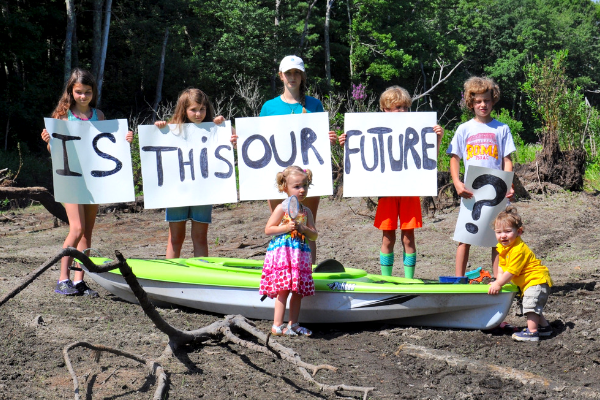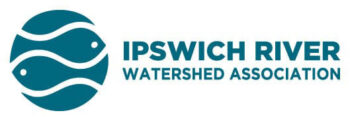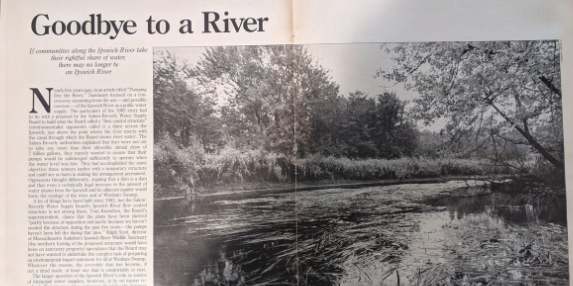Above Over 30 years ago, the article above appeared in Mass Audubon’s Sanctuary magazine. Decades later, water policy remains outdated and the river still struggles to survive.
It’s a 90-degree day, with only parched clouds scattered in the sky. There hasn’t been rain for over a week. A kayaker slogs by, dragging his boat over the exposed gravel where water should be flowing. This isn’t a scene from California, but right here all over Massachusetts during 2016 and in 2020, or at some places in the Ipswich River Watershed in most years.
This year, however, has seen record highs for summer flow in many of the state’s rivers and streams. More rain might seem like a good thing, particularly for flow-stressed rivers like the Ipswich and Parker. But all rain is not created equal. Heavy storms that drop a lot of water all at once result in flooding that erodes banks, leads to fallen trees, and washes pollutants such as fertilizer, oil, and pesticides, into rivers and streams, as well as flushing quickly out to sea rather than recharging the groundwater
Our state is sitting smack dab in the center of the climate crisis, struggling to adjust to both drought and flooding. And our current state water policy is falling behind. Despite decades of data and research giving advance warning, MA state policy has not advanced to where it needs to be to address the future of society’s most important resource: water.
This policy failure can be summed up easily. At a time when half of the country is stuck in months-long drought (and subsequent fires), Massachusetts still does not require water users to conserve during a drought; in fact the majority of water users are exempt from any conservation requirements even during severe droughts! Thankfully the State has begun to signal they may finally be open to making modest changes. This summer, they proposed for the first time that water conservation requirements be required on the largest category of exempt withdrawals during State-declared droughts. We hope this is the first step in catching up to the times.
Why has it been so difficult to make this much needed change to reduce our water use when we are already in dire straits?
Part of the problem is public perception. Water users are often kept out of the loop as far as their water use habits. Most renters never even see their water bills, and often homeowners only see quarterly or semi-annual bills. This makes it hard for individuals to understand how much water they are using or see progress when they change their water use habits. Without this information, it’s understandable that residents of a generally wet state like Massachusetts wouldn’t know to worry about their water usage.
The problem is systematic as well. Water suppliers need to focus their jobs on supplying clean, reliable water to their users, but they are working with decades (and sometimes centuries) old infrastructure to do so. Meanwhile, new threats to water quality are always being identified that suppliers must test for and, if possible, treat. Challenges such as these often require their full attention such that water conservation takes a back seat.
And here is the paradox. Water users like you generally pay for improvements to our water treatment facilities, testing, and reporting as part of their water bill. This means that the people in charge of making sure you have enough clean, reliable water can only do that if people are using enough water. This at a time when we are experiencing frequent droughts and know that more droughts are on the way. Making suppliers reliant on selling water to do their work at a time when water conservation is paramount is an unworkable system. Added to that, it promotes conflict between water stakeholders.
The harsh truth is that our state is operating under outdated rules that have no basis in our current reality. What’s worse, this situation has been with us for decades. The Ipswich River, which flows from Burlington to Ipswich, has been nationally recognized as one of the country’s Most Endangered Rivers® not once, not twice, but three times. Each time, advocates appealed to the state to make the badly needed changes that would save the river and make our entire state more resilient. Yet even today more than 90% of water use in the Ipswich watershed is exempt from any State water conservation requirements.
While grassroots efforts and municipal leaders have made wins in the last 30 years, the Ipswich River is still at risk, and with it, the drinking water of over 350,000 people. We can cover our eyes and pretend otherwise, but more droughts and floods are coming. What might our future look like if we wait decades more to take action?



Hi,
Is there any pending legislation in regards to change the conservation efforts? I want to make our Beverly community more aware of the issue but feel at a loss of knowing governmentally who may be working on policy changes. I will share this terrific article with my church community. Thank you.
Hi Leslie,
That’s great, we’re really grateful to you and the First Baptist Church of Beverly for continuing to support the river. We’ll have a more comprehensive Advocacy update in our Fall newsletter (arriving in mailboxes in November), but for now a great first step is to reach out to your state senator and rep, which for Beverly are Senator Joan Lovely and Rep Jerald Parisella.
Thanks,
Rachel